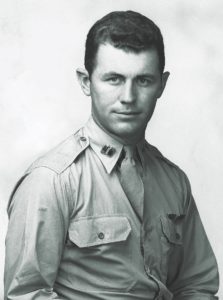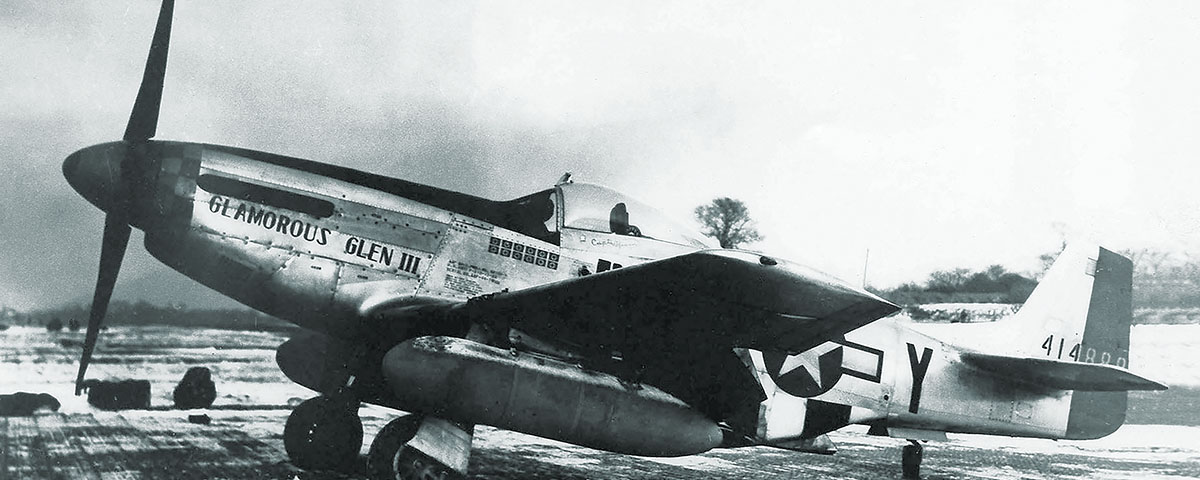Legendary pilot Chuck Yeager flew numerous combat missions during World War II. Here are some of his stories.
Charles Elwood “Chuck” Yeager didn’t make the record books as the highest-scoring fighter ace in American aviation history, nor was he the only hotshot test pilot to have flown the rocket-powered Bell XS-1. Yet he’s widely considered to be the greatest military pilot of all time, or at least the best known. Yeager’s signal achievement—becoming, in 1947, the first person to fly faster than the speed of sound—often overshadows his achievements as a World War II ace. Enlisting in the U.S. Army Air Corps in September 1941, the 18-year-old West Virginian started out as an aircraft mechanic but quickly rose through the ranks to become a flight officer. Within two years Yeager was flying the skies of Western Europe in Glamorous Glen, a P-51 Mustang he’d named after his fiancée, Glennis Faye Dickhouse. On March 5, 1944, Yeager was shot down over France on his eighth combat mission, and his subsequent escape into Spain and then his campaign to immediately rejoin the fight have become the stuff of legend. “It wasn’t in the Germans’ training,” Yeager later recalled for Aviation History magazine, “to catch a West Virginian in the woods.”
The following excerpts from Yeager’s after-action reports, spanning more than nine months of combat in 1944, detail, in his own words, his first air victory, his escape from France, and the day he shot down five Messerschmitt 109Gs, officially becoming an ace pilot.
March 4, 1944
Leading the second element of Chambers White Flight [an element of the 363rd Squadron, 357th Fighter Group], I was flying at 26,000 feet when I spotted an Me 109 to the right and behind us about 2,000 feet below. I broke to the right and down. The E/A [enemy aircraft] turned right and down and went into a 50-degree dive. I closed up fast and opened fire at 200 yards. I observed strikes on [the] fuselage and wing roots, with pieces flying off. I was overrunning, so I pulled up and did an aileron roll and fell in behind again and started shooting at 150 yards. The E/A engine was smoking and windmilling. I overran again, observing strikes on [the] fuselage and canopy. I pulled up again and did a wingover on his tail. His canopy flew off and the pilot bailed out and went into the overcast at 9,000 feet. The E/A had a large red and black “Devil’s Head” on the left side of the ship. The E/A took no evasive action after the first burst.
May 22, 1944
Three Fw 190s [Focke-Wulf 190As] came in from the rear and cut my elevator cables. I snap-rolled with the rudder and jumped at 18,000 feet. I took off my dinghy pack, oxygen mask, and helmet in the air; and then, as I was whirling on my back and began to feel dizzy, I pulled the ripcord at 8,000 feet. An Fw 190 dove at me, but when he was about 2,000 yards from me a P-51 [Mustang] came in on his tail and blew him to pieces.
I landed into a forest clearing in which there was a solitary sapling about twenty feet tall. I grabbed the top of the sapling as I passed it and swung gently to the ground. My chute was hung up in the tree….I hid my Mae West [personal flotation device] and started off to the southeast, for I thought that I was in the forbidden

zone. Before I had gone 200 feet, half a dozen Frenchmen ran up to me. Some of them got my chute down, and one of the men took me by the arm and led me to a house some 200 yards away. There, I was given food and civilian clothes. A gendarme was seen approaching the house at this moment, and so I was quickly hidden in the barn. When the gendarme left
I was brought back into the house where one of the men who had left the group now returned and gave me a note in English telling me to trust the people in whose hands I was. I was then taken to another house about a kilometer away, and from there my journey was arranged.
September 13, 1944
I was leading Cement Blue Flight when I spotted a Me 109 diving straight down around 15,000 feet. I rolled over and was pulling around 70″ Hg. I caught the E/A on the deck diving around 450 to 500 mph. I closed up fast and started firing around 300 yards. I observed strikes on [the] engine and fuselage. The engine started smoking and windmilling. I overshot. Lieutenant Gailer [Frank L. Gailer Jr.] fired at him until the E/A attempted to belly in. The E/A exploded when it hit the ground. I took a picture of the crash.
I was using a K-14 sight [gunsight] and it is very satisfactory. The pattern is much too spread on the P-51D [the fourth model of the Mustang].
October 12, 1944
I was leading the group with Cement Squadron and was roving out to the right of the first box of bombers. I was over Steinhuder Lake when 22 Me 109s crossed in front of my squadron from 11 o’clock to 1 o’clock. I was coming out of the sun, and they were about 11/2 miles away at the same level of 23,000 feet. I fell in behind the enemy formation and followed them for about three minutes, climbing to 30,000 feet. I still had my wing tanks and had closed up to around 1,000 yards, coming within firing range and positioning the squadron behind the entire enemy formation. Two of the Me 109s were leaning over to the right. One slowed up and before I could start firing, rolled over, and bailed out. The other Me 109, flying his wing, bailed out immediately after as I was ready to line him in my sights.
I was the closest to the tail-end of the enemy formation and no one but myself was in shooting range and no one was firing. I dropped my tanks and then closed up to the last Jerry [German] and opened fire from 600 yards, using the K-14 sight. I observed strikes all over the ship, particularly heavy in the cockpit. He skidded off to the left and was soaking and streaming coolant and went into a slow diving turn to the left. I was closing up on another Me 109, so I did not follow him down. Lieutenant [John] Stern, flying in Blue Flight, report[ed that it was] on fire as it passed him and went into a spin.
I closed up on the next Me 109 to 100 yards, skidded to the right [and] took a deflection shot of about 10 degrees. I gave about a three-second burst and the whole fuselage split open and blew up after we passed. Another Me 109 to the right had to cut his throttle and was trying to get behind. I broke to the right and quickly rolled to the left on his tail. He started pulling it in and I was pulling 6 “G” [force]. I got a lead from around 300 yards and gave him a short burst. There were little hits on [the] wings and tail section. He snapped to the right three times and bailed out when he quit snapping at around 18,000 feet. I did not black out during this engagement [thanks] to the efficiency of the G suit. Even though I was skidding, I hit the second Me 109 by keeping the lead and range on the E/A. To my estimation the K-14 sight is the biggest improvement to the combat equipment for fighters up to this date. The Me 109s appeared to have a typ[e] of bubble canopy and ha[d] purple noses and [were] a mousey brown all over. I claim[ed] five Me 109s destroyed.
November 6, 1944
I was leading White Flight in Cement Squadron when, north of Osnabrück at 1100 hours, I spotted three [Messerschmitt] Me 262s going 180 degrees to us at about 2 o’clock low. We were at 8,000 feet. Cement leader saw two more low and going in the same direction as we were. I and my flight turned to the right and headed the last man off. I got a 90-degree deflection burst at around 400 yards. I only got a hit or two on him before he pulled away. They were flying a loose “V” formation and they did not take any evasive action but seemed to depend on their superior speed. They pulled out of range in the haze.
We were flying along an overcast which was very thin, and the edge of it was over to the right. Altitude about 5,000 feet. I went down under it and flew along a minute or two and I met them head-on again, only they were now flying about 2,000 feet. I split s–ed [a “split s” is a 180-degree roll and descending half loop] on the leader and they all separated, and I fired a high deflection burst from above on the leader. I got behind him and was pulling 75″ Hg. I was indicating 430 mph. I fired two or three bursts and got hits on the fuselage and wings from 300 yards. Then he pulled away and went into the haze and I lost him.
In this engagement I lost the rest of the flight and found myself alone. I climbed to 8,000 feet and headed north. I found a large airfield with black wide runways about 6,000 feet long and started flying around it. I got a few bursts of flak, but it was very inaccurate. I spotted a lone [Me] 262 approaching the field from the south at 500 feet. He was going very slow (around 200 mph). I split s–ed on it and was going around 500 mph at 500 feet. Flak started coming up very thick and accurate. I fired a short burst from around 400 yards and got hits on the wings. I had to break off at 300 yards because the flak was getting too close. I broke straight up, and looking back I saw the jet E/A crash-land about 400 yards short of the [air]field in a wooded field. A wing flew off outside the right jet unit. The plane did not burn. I claim[ed] one Me 262 destroyed and two Me 262s damaged. MHQ
[hr]
This article appears in the Autumn 2018 issue (Vol. 31, No. 1) of MHQ—The Quarterly Journal of Military History with the headline: The Ace






